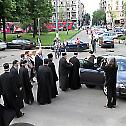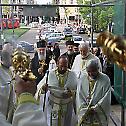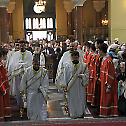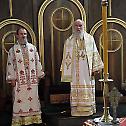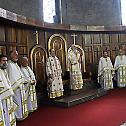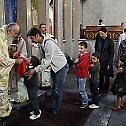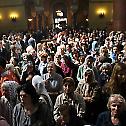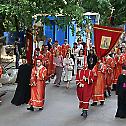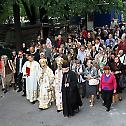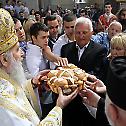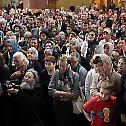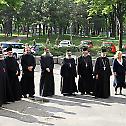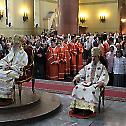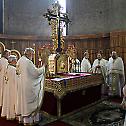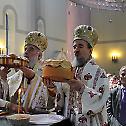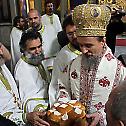Slava of St. Mark's church
On the feast day of Holy Apostle and the Evangelist Mark, His Holiness Irinej, Serbian Patriarch served the Divine Liturgy in Belgrade's church devoted to this martyr of Christ.
His Holiness was concelebrated by His Grace Bishop Atanasije of Hvosno, thirteen priests and five deacons of the Archbishopric of Belgrade-Karlovac.
Cutting the slava cake Serbian Patriarch Irinej congratulated church slava to the head of the church protopresbyter-staurophor Trajan Kojic and to the priests., expressing the significance of this great feast for the Orthodox Church.
About the church of Saint Mark www. crkvasvetogmarka.rs
A Christian place of worship has existed continuously in what is today Tašmajdan Park from at least the nineteenth century. The original St. Mark's Church, built in the days of Belgrade Metropolitan Petar Jovanović (1833-1859) and Prince Miloš Obrenović (1835-1836), stood in almost the same location, just slightly south of the present building. At a time when Turkish troops were still quartered in the city and the present-day Orthodox Cathedral (Saborna crkva), for example, was built of wood, this was a great spiritual event for Belgrade.
The patron endower of the church was Lazar Panča, a merchant originally from the village of Katranica in Southern Serbia who died in Belgrade in 1831. The church was located in a cemetery, as is often the case, and the cemetery was taken care of by the church Administration. There was a quarry of rock (and saltpeter) in Tašmajdan that was also in use in the time of the Turks and later used to build many things in present-day Belgrade. According to accounts by contemporaries, before St. Mark's Church was actually built a Cross was placed on that spot and a shade tent where Holy Liturgy and religious processions in Palilula were held. Sreten Popović, a Belgrade native, wrote in the 1870's "that there were some ruins there and that they were said to be from an old church, which by all accounts was dedicated to St. Mark". The same writer mentions the hilltop grave where the sultan's edict (hatisherif) was readin 1830.
The old St. Mark's Church was a rectangular building whose exterior surface area was 11.5 by 21 meters and whose interior, usable space was 7.75 by 17.46 meters. At the same time Prince Miloš Obrenović built the palatial church of the Holy Apostles Peter and Paul in Topčider (completed in 1834). Work on both churches was supervised by Hadži-Nikola Živković from Vodeni (1792-1870), the first great builder in the restored Serbia, and his master builders Janja and Nikola.
From the very beginning of the church's existence, as early as 1838, it was the burial place of Prince Milan Obrenović, the oldest son of Prince Miloš Obrenović, who rested "to the right of its west doors and the dust of the late Bishop of Šabac, Gavrilo (Popović), who rests to the left of the west doors in the church itself". After the bloody dynastic overthrow in May 1903, the royal couple, King Alexander Obrenović I and Queen Draga Obrenović, were buried in this church.
In about 1870 St. Mark's Church had two parishes, that of Terazije with 312 homes and Palilula with 318 homes.
During World War I the Austrian conquerors restored the church in 1917. The original church existed until the beginning of World War II. During the German bombing on Palm Sunday,
April 13, 1941, the church caught fire and the damage was so extensive that its remains were completely removed in 1942.
The New Church
Because of the rapid growth of the city and the increase in the number of residents, it became necessary by the beginning of the twentieth century to build a bigger church in the Belgrade quarter of Palilula. Frequent wars did not allow this until 1930 when a pair of Belgrade architects, the brothers Petar and Branko Krstić, both professors of the Faculty of Architecture, designed the plans for the new St. Mark's Church.
The present building of St. Mark's Church was built according to their drawings between 1931 and 1940. The eruption of World War II interrupted the full completion of the church. Only the construction work was finished. Divine service took place in the new church during the war and after it until November 14, 1948 in the adapted narthex of the church. On that date the church was consecrated (by Patriarch Gavrilo Dožić) and the church opened for divine service. There were plans to decorate the whole interior with frescoes.
In construction style, the church is a monumental edifice built in the spirit of Serbian medieval buildings, using as a model the endowment of King Milutin, Gračanica Monastery near Priština in Kosovo. Of course, the dimensions of the church are much larger and everything appears grand and powerful. The external walls are in two colors of natural materials in the Serbian-Byzantine building method. This church is a good example of how beautiful old spiritual models fashioned with new building materials can appear in an urban setting without losing anything of their authenticity and simplicity.
The church bell tower is a part of the church itself on the west side.
The Church Interior
St. Mark's Church is 62 meters long and 45 meters wide, and the height of the main cupola to the base of the cross is 60 meters. The usable interior surface area of the church is about 1,150 square meters, and the naos (nave) of the church can accommodate over 150 singers.
It has already been said that more than seventy years after the beginning of its construction, St. Mark's Church has not been completed. This relates primarily to its interior, decorating, fresco painting, appropriate lighting, acoustics, heating and ventilation. After World War II little was done in the church itself for objective reasons.
Above the entrance door to the church on the external façade is an icon in mosaic of the Holy Apostle and Evangelist Mark, the work of Veljko Stanojević in 1961.
The floor in the church is from 1974, while the floor of the soleia (area in front of the iconostasis and the altar (sanctuary) was done in marble in 1991.
The iconostasis of the church, designed by architect and professor Zoran Petrovi?, dates back to 1991/1992 and was done in marble, while the icons in it are done in mosaic, the work of academic painter Đuro Radlović from Belgrade from 1996-1998. The altar table is also in marble with smaller mosaics on the front side. To the right of the altar is a smaller altar dedicated to the Holy Despot Stefan Lazarević († 1427), and the altar on the north side is dedicated to the feast day of the Transfiguration of the Lord.
As one enters the church on the right side along the south wall of the church is the marble tomb of Emperor Stefan Dušan († 1354) designed by Dr. Dragomir Tadić where his holy relics rest after being transferred from his endowment, Holy Archangels Monastery near Prizren, a monastery that has lain in ruins for centuries. On the opposite, north side the tomb of Patriarch German (Đorić, † 1991) has been built in the same style and of the same material.
In the middle of the church underneath the central cupola is apolielei done in copper according to the design of Dr. Dragomir Tadić in 1969, and executed by academic sculptor Dragutin Petrović.
Below the narthex of the church is the crypt which was adapted during 2007. It was iinstalled new ground marble, climatisation and ventilation, sound system and graves ware readopted. In it are several tombs transferred from the original church: Metropolitan Teodosije (1815-1892), Bishop Viktor of Niš Viktor (1797-1888), Bishop Gavrilo (Popović, 1811-1871) of Šabac, and Bishop Mojsije of Timok (1835-1896). Also interred here are King Alexander Obrenović and Queen Draga (†1903), Ana Jovana Obrenović (†1880), Princes Milan M. Obrenović (1819-1839) and Sergije M. Obrenović († 1878), and the grave of the patron endower of the old church, Lazar Panča. Generally speaking, the entire space of the very large crypt is little used and suitable for a gallery, museum or display area.
The church treasury is presently located in a room on the south side and contains a rich collection of icons and precious artifacts. The most valuable icons are
Theotokos with Christ from the 16th century;
Jesus Christ on the Throne, an icon from the end of the 18th century;
St. Nicholas on the Throne,
Holy Emperor Constantine and Empress Helen,
an icon from the first half of the 19th century;
St. Demetrios and St. George, an icon from 1849;
Theotokos with the Saints, an icon from the first half of the 19th century;
St. George and St. Demetrios, an icon from the mid-19th century;
Crowning of the Most Holy Theotokos, an icon from the mid-19th century;
Holy Emperor Constantine and Empress Helen (Exaltation of the Honorable Cross), an icon from the mid-19th century;
Theotokos with Christ, the Holy Prophet Daniel and St. John the Baptist, an icon from 1863;
Theotokos of Arabia, an icon from 1872;
St. Sava of Serbia, an icon from 1870;
Holy King Stefan of Dečani, an icon from 1883;
Holy Apostle and Evangelist Mark, an icon from the end of the 19th century;
Holy Archangel Michael, an icon from 1889;
the Pilgrims' icon (the Theotokos, Jesus Christ, the apostles, the Final Judgment), an icon from the end of the 19th century;
St. George Killing the Dragon, an icon from 1926; and many other icons.
The icons are primarily the work of our eminent painters and icon painters of the 19th and 20th centuries: Steva Todorović, Nikola Marković, Dimitrije Posniković, Vladimir Vojnović, Pavle Čortanović, Lukijan Bibić, Vasa Pomorišac, Đorđe Popović, Olga Krdžalić and others.
Founding Charter
"In the name of the Father, the Son and the Holy Spirit, we do hereby consecrate the cornerstone of this church of God dedicated to the Holy Apostle and Evangelist Mark in the Capitol of Yugoslavia, the Royal City of Belgrade, next to the old St. Mark's Church, on the church patronal feast, April 25 (May 8 according to the new calendar) in the year 7439 since creation and the year 1931 since the Incarnation of our Lord during the joyous reign of His Majesty King Alexander Karađorđević I of Yugoslavia, and the Head of the Serbian Orthodox Church, His Holiness Patriarch Varnava, who executed this holy act of consecration.

